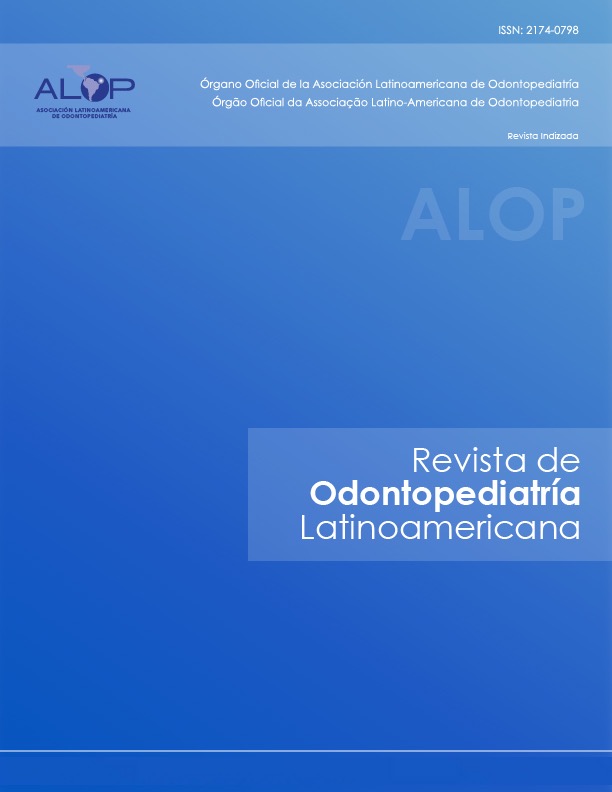Orodental profile and associated factors with oral caries in childrens of Bogotá
DOI:
https://doi.org/10.47990/alop.v2i1.78Keywords:
dental caries, epidemiology, habits, child, preschool, prevalence, oral hygieneAbstract
Objective: To determine the oral epidemiological profile and the factors related to eating habits and oral hygiene associated with caries, in children from 2 to 4 years, members of the EPS Sanitas in Bogotá. Material and methods: A cross sectional study was made, with application of an instrument to evaluate the profile and the habits of hygiene and diet of each patient. The evaluators were specialists in Pediatric Dentistry, and in each case informed consent was signed. Results: 352 children were evaluated. 58.2% had no caries, 73% had no fillings, and 94% had teeth extracted. It was reported that 29.5% of the children had white spot lesions. The prevalence of caries in children aged 2 years was 37.36% and for children with 3 and 4 years the prevalence was 40.87% and 55.55% respectively. The ceo-d total index was 2.51. 73% of the children brush their teeth less than 3 times a day, 38.2% say that no one provides oral health education and 47% consume food in the evening after the last brushing. No statistical association was documented between the presence of caries and the other variables included. Conclusions: It is recommended to strengthen education to children and caregivers related to oral hygiene and feeding and to realize further studies to assess the impact of measures implemented.
References
American Academy of Pediatric Dentistry. Clinical guideline on infant oral health care. Pediatric Dentistry 2003; 25 (7):54
Kroll, R. Stone, J. Nocturnal Bottle-Feeding as a Contributory cause of Rampant Dental Caries in the infant and Young Child. Journal of Dentistry for Children. 1967; l(34):454
Ripa, L. Nursing Caries: a comprehensive review. Pediatric Dentistry1988;10(4): 268
ICDAS INTERNATIONAL CARIES ASSESSMENT AND DETECTION SYSTEM. ICDAS Foundation 2010. Disponible en www.icdas.org
Olivar, A. Atención estomatológica al binomio madre-hijo. Colombia: Editorial Universidad Nacional de Colombia. Odontología; 2006.
Johnsen, D. Background comparisons of pre 31/2 year old children with nursing caries in four practice settings. Pediatric Dentistry. 1984; 6(1):50.
Herman, H. Preventive dental care: The role of the pediatrician. Pediatrics.1987; 80(1):108.
Kotlow, L. Breast feeding: A cause of dental caries in children. Journal of Dentistry for Children. 1977; May-Jun:25.
Bouga-Paraskaki, A. The use of the Nursing Bottle. Journal of Dentistry for Children. 1973; July-August: 51
Ekstrand, KR. Oclusal Caries: Pathology, Diagnosis and Logical Management. Dent Update 2001; 28: 380-387
Eronat, N. Eden, E. A comparative study of some influencing factor of rampant or nursing caries in preschool children. Pediatric Dentistry. 1992; 16:15
Mc. Donald. R. Odontología Pediátrica y del Adolescente. Argentina, Editorial Médica Panamericana. 1990
Bordoni N; Castillo R, Escobar, A; Odontología Pediátrica La salud bucal del niño y el adolescente en el mundo actual. 1ª ed. Buenos Aires: Editorial Médica Panamericana;2010
Ayhan, H. Influencing factors of nursing caries. The Journal of Clinical Pediatric Dentistry. 1996;20(4):313
Ott, T. Kummer, A. Premature loss of the maxillary primary incisors: Effect on speech production. Journal of Dentistry for Children. 1995; May-Jun: 173
Schwartz, S. A child´s sleeping habit a cause of nursing caries. Journal of Dentistry for Children. 1993; Jan-Feb: 22.
Riekman, G. Effect of premature lost of primary maxillary incisors on speech. Pediatric Dentistry. 1985;7(2):119-122.
Koroluk, L. Parental perceptions of the effects of maxillary incisor extractions in children with nursing caries. Journal of Dentistry for Children. 1991;May-Jun: 233-236
Ministerio de Salud, República de Colombia. Centro Nacional de Consultoría. III Estudio Nacional de Salud Bucal ENSAB III Colombia. Bogotá; 1999. Disponible en http://onsb.udea.edu.co/site/images/pdf/ensab3.pdf
OMS/FDI Metas de Salud Bucal para el año 2000. Ginebra 1979.
Chavarro, I. Prevalencia de caries del lactante y posibles factores asociados en preescolares de instituciones de Bogota, Presentación de resultados. Revista Pediatría 2001; 36 (2). Disponible en www.encolombia.com/medicina/pediatria/pedi36201-prevalencia.htm
OMS. Encuesta de Salud Bucodental métodos básicos. 4ª ed. Ginebra. 1997. Disponible en http://apps.who.int/bookorders/anglais/detart1.jsp?sesslan=1&codlan=3&codcol=15&codcch=4275
Ministerio de Salud, República de Colombia. Centro Nacional de Consultoría. III Estudio Nacional de Salud Bucal ENSAB III Colombia. Bogotá; 1999. Disponible en http://onsb.udea.edu.co/site/images/pdf/ensab3.pdf
Chavarro, I. Prevalencia de caries del lactante y posibles factores asociados en preescolares de instituciones de Bogotá, Presentación de resultados. Revista Pediatría 2001; 36 (2). Disponible en www.encolombia.com/medicina/pediatria/pedi36201-prevalencia.htm
Downloads
Published
Issue
Section
License
Copyright (c) 2012 Latin American Pediatric Dentistry Journal

This work is licensed under a Creative Commons Attribution-NonCommercial-ShareAlike 4.0 International License.























